 THE MINERAL BROCHANTITE
THE MINERAL BROCHANTITE
- Chemistry: Cu4SO4(OH)6, Copper Sulfate Hydroxide.
- Class: Sulfates
- Uses: A minor ore of copper and as mineral specimens.
Specimens
Brochantite is similar to other fibrous green copper minerals that form in oxidation zones such as the carbonate mineral malachite, the halide mineral atacamite and the closely related sulfate mineral antlerite. This brings up a number of identification problems. Acicular malachite will effervesce in warm hydrochloric acid and brochantite will not. Atacamite is slightly softer and is usually less transparent. Antlerite is all but indistinguishable by ordinary means although its terminations are typically flatter than the rounded terminations of brochantite.
PHYSICAL CHARACTERISTICS:
- Color is a bright emerald green or dark green to almost black.
- Luster is vitreous to pearly on cleavage surfaces.
- Transparency: Crystals are transparent to translucent.
- Crystal System is monoclinic; 2/m.
- Crystal Habits include acicular or fibrous crystals aggregated into coatings and tufts as well as small tabular crystals and reniform, massive or granular specimens. Terminations tend to be rounded or dome-like. Twinning is common and gives an orthorhombic look to larger crystals.
- Cleavage is perfect in one direction nearly perpendicular to length.
- Fracture is uneven.
- Hardness is 3.5 - 4
- Specific Gravity is approximately 3.9+ (above average for translucent minerals)
- Streak is green.
- Other Characteristics: Does not effervesce in hydrochloric acid.
- Associated Minerals are
limonite,
cuprite,
chrysocolla,
cyanotrichite,
malachite,
langite ,posnjakite and azurite. - Notable Occurrences include numerous locations in Chile; Ural Mountains, Russia; England; Italy; Romania; Zaire and several locations in Arizona, Nevada, California, New Mexico and Utah, USA.
- Best Field Indicators are crystal habit, associations, hardness, cleavage, non-reaction to hydrochloric acid and color.
 Amethyst Galleries' Mineral Gallery MINERALS |
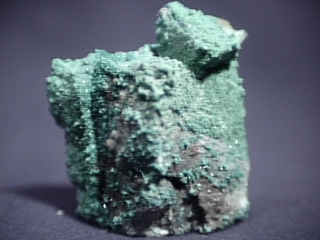
BROCHANTITE specimen bro-1
$ 115.00
$ 115.00
Dims: 2.2" x 2.0" x 1.3"(5.6 x 5.1 x 3.3 cm)
Wt: 6.40 oz.(181.6 g)
Sunshine #1, Blanchard Mine, Bingham, New Mexico, U.S.A.
Countless tiny Brochantite crystals form one of a series of crusts that coat part of the galena base of this specimen. It occurs in a few different forms: fibrous and radiating, crystalline, and massive. It has a grass-green color and vitreous to dull luster, and it appears to be opaque. There are variations in the green color that concur with changes in both the luster and crystal form, so I am thinking that maybe there is another copper mineral mixed in with the Brochantite. There appears to be a very thin, erratic layer of a blue mineral(probably linarite) underneath the Brochantite layer. It has a waxy luster and discernable but indefinite crystal form. This rests on part of a layer of chalky, dull, beige-colored material that I actually believe may be a massive variety of cerussite! I am, of course, unsure about this, but the color and the environment are right, and there does seem to be a bit of calcite attached to it in one spot. This material almost completely covers the galena, but bits are visible down inside a network of rectangular "holes" that make up a small and very strange framework in the "cerussite" patch. We had a linarite specimen available that was a bit like this piece, but this is, in my opinion, quite a bit more impressive.
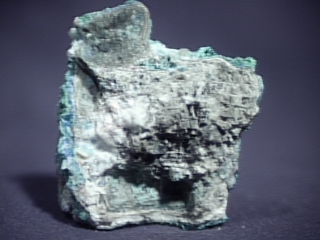

bro-1 ($115.00)
Sunshine #1, Blanchard Mine, Bingham, New Mexico, U.S.A.
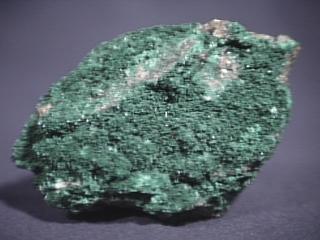
BROCHANTITE specimen bro-2
$ 27.00
$ 27.00
Dims: 3.3" x 2.4" x 1.9"(8.4 x 6.1 x 4.8 cm)
Wt: 9.07 oz.(257.3 g)
Bou B'ker, Morocco
The quartzite host rock of this specimen is partially covered by a crust made up of hundreds of green Brochantite crystals. These crystals are extremely small, not exceeding 1 mm in any dimension, and have an almost prismatic form that can be clearly seen under 10-power maginification, and the standard radiating habit. Their color is dark green and they have a rather dull, waxy luster. Besides the Brochantite, there are a few small patches of what appear to be azurite, but could be linarite. This material shows no crystal form, just a moderate blue color. The quartzite host rock is stained a red-brown color, likely from rust.

bro-2 ($ 27.00)
Bou B'ker, Morocco
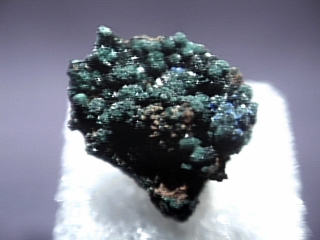
BROCHANTITE specimen bro-3
$ 18.00
$ 18.00
Dims: 0.9" x 0.9" x 0.4"(2.3 x 2.3 x 1.0 cm)
Wt: 4.6 g w/ foam base
Grandview Mine, Coconino County, Arizona, U.S.A.
Though quite small, this Brochantite thumbnail specimen has beautiful, deep green coloration and well-preserved botryoidal form. It occurs as fine, tiny crystals that formed round aggregates which are clustered together in a thin crust. The Brochantite has a beautiful, deep forest-green coloration and its aggregates have a sparkle that in some places resembles a silky sheen. Though individual crystals may be transparent, the aggregates that these have formed are opaque. Besides the Brochantite, there are several tiny, round clusters of acicular cyanotrichite crystals scattered about on one area of the specimen. Though a loupe or magnifier is needed to see them in detail, their bright-blue color and acicular, radiating habit is clearly visible to the naked eye. Besides these minerals, there is a small amount of limonite host rock on the specimen. The piece is affixed to a foam base that fits inside a plastic specimen box.

bro-3 ($ 18.00)
Grandview Mine, Coconino County, Arizona, U.S.A.
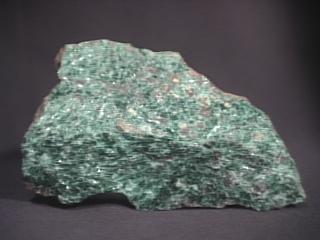
BROCHANTITE specimen bro-4
$ 45.00
$ 45.00
Dims: 5.1" x 3.4" x 1.4"(13.0 x 8.6 x 3.6 cm)
Wt: 13.9 oz. (395 g)
Morenci Mine, Morenci, Arizona, U.S.A.
Two faces of the host rock of this specimen are covered with a thin layer of Brochantite. It occurs as sprays of acicular, radiating needles that are flattened against the base, radiating outwards in a 360-degree arc along one plane. Some of these crystals measure over 1: (2.5 cm) in length. All have a dark green color and a pearly to vitreous luster, and show some translucence, even against the opaque quartzite base. It is a very colorful specimen.
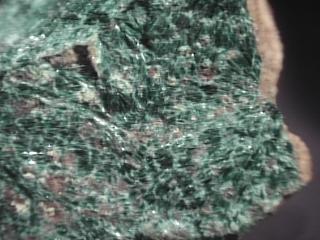

bro-4 ($ 45.00)
Morenci Mine, Morenci, Arizona, U.S.A.
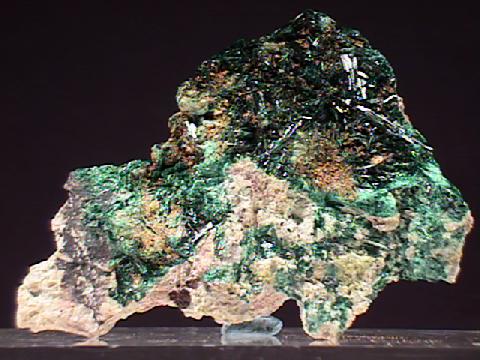
BROCHANTITE specimen bro-5
$ 45.00
$ 45.00
Dims: 2.7 x 1.8 x 0.6" (6.9 x 4.6 x 1.5 cm)
Wt: 1.14 oz. (32.3 g)
Morenci Mine, Morenci, Arizona, U.S.A.
This specimen contains some of the largest and most well-formed Brochantite crystals in our stock. Though many of the crystals are obviously damaged, at least half of them are in good to excellent condition. The longest of these measures 0.5" (1.3 cm) and though it is intergrown, has good monoclinic prismatic form. A few stubby crystals extend from the crust and possess excellent terminations. They are all generally well-defined, with sharp edges and clean faces. Their dark green coloration and pearly luster are standard for their species, and many show definite translucence and even dim transparence if viewed under magnification. The pale brown host rock appears to be made up of quartz and other minerals, and almost has a greenish caste to it.
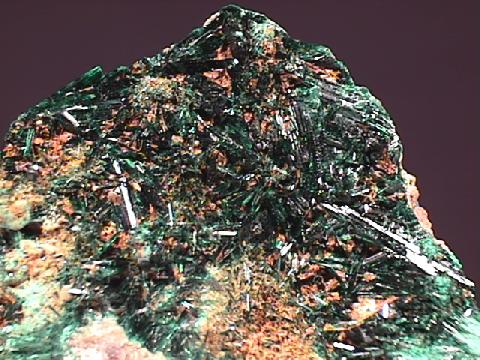

bro-5 ($ 45.00)
Morenci Mine, Morenci, Arizona, U.S.A.
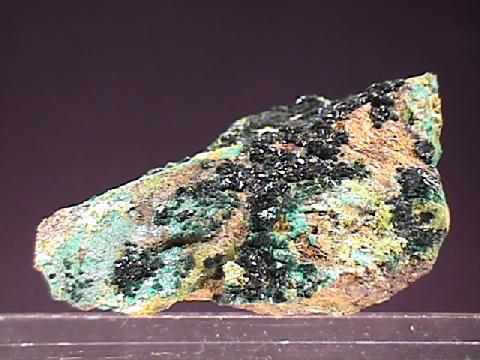
BROCHANTITE specimen bro-6
$ 33.00
$ 33.00
Dims: 2.8 x 1.8 x 1.0" (7.1 x 4.6 x 2.5 cm)
Wt: 3.42 oz. (96.9 g)
Ludwig, Lyon County, Nevada, U.S.A.
I believe that this is the first Brochantite specimen that we have had from this locality. The Brochantite occurs as a thin crust and several isolated clusters that rest on an iron-bearing host rock. Though a few of the isolated clusters are damaged, the specimen is generally in very good condition. The crust is made up of scores of tiny, round nodular clusters of even tinier crystals, but there are a few larger clusters that have a much more visible crystal form. Even so, the crystals in these larger clusters are heavily intergrown and very small, so studying their monoclinic bladed form is very difficult. All have the standard deep green color of Brochantite, and the larger clusters show a bright, vitreous luster- the smaller ones appear to be quite dull, but are much more translucent under bright light, whereas the larger ones are generally nearly opaque. They are accompanied by thin crusts of what I believe is chrysocolla, as it has the proper color, luster, and slightly reniform undulations that would be expected. These thin chrysocolla crusts permeate the rusty-brown host rock.

bro-6 ($ 33.00)
Ludwig, Lyon County, Nevada, U.S.A.
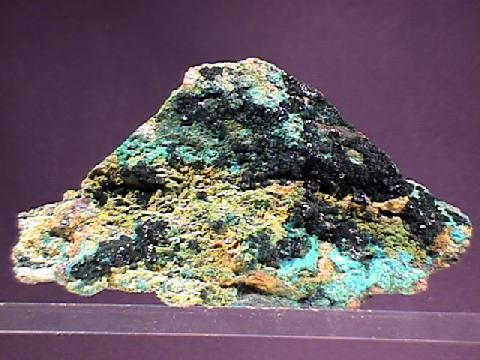
BROCHANTITE specimen bro-7
$ 50.00
$ 50.00
Dims: 4.1 x 2.3 x 1.2" (10.4 x 5.8 x 3.0 cm)
Wt: 8.22 oz. (233.2 g)
Ludwig, Lyon County, Nevada, U.S.A.
Several dozen intergrown Brochantite clusters partly coat the dull brown host rock of this hand specimen. Each of these clusters is in good condition, and none exceed 0.2" (5 mm) in any dimension. Most are intergrown into small crusts, but a few are isolated. Most of these clusters are round and botryoidal, showing little crystal form and a waxy luster. However, several are obviously made of partly intergrown blades that are heavily intergrown but have a reasonably good (though warped) monoclinic form. These clusters have a brighter, pearly luster. All have the classic deep green coloration of Brochantite and are only dimly translucent at best. They are accompanied by bright aqua-blue crusts of what appears to be massive chrysocolla that coats small portions of the surface of the host rock.

bro-7 ($ 50.00)
Ludwig, Lyon County, Nevada, U.S.A.
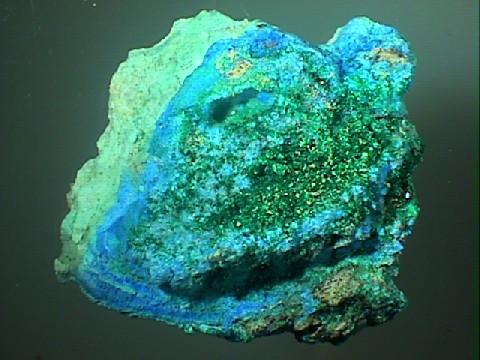
BROCHANTITE specimen bro-8
$ 30.00
$ 30.00
Dims: 2.0 x 1.8 x 1.2" (5.1 x 4.5 x 3.1 cm)
Wt: 1.0 oz. (28 g)
Grandview Mine, Coconino County, Arizona, U.S.A.
A crust made up of countless tiny, intergrown Brochantite rests on the copper-bearing base of this hand specimen. The crystals are too small to effectively study, but the crust appears to be in very good condition. Their monoclinic tabular form appears to be good, and all have the classic deep green color and a pearly luster. They rest on a bed of massive and fibrous cyanotrichite, most of which is matted down. This layer in turn rests on a layer of very soft shale or mudstone.

bro-8 ($ 30.00)
Grandview Mine, Coconino County, Arizona, U.S.A.

BROCHANTITE specimen bro-9
$ 25.00
$ 25.00
Dims: 2.1 x 1.9 x 1.8" (5.3 x 4.8 x 4.6 cm)
Wt: 4.1 oz. (117 g)
Blanchard Claims, Bingham, Socorro County, New Mexico, U.S.A.
Several dozen fine Brochantite needles rest on the quartzite base of this large hand specimen. These needles do not exceed 0.2-0.3" (5-8 mm) in length and appear to be in very good condition, showing little damage. Though they are a bit too fine to effectively study with a loupe, their monoclinic form is likely very good. All have the classic green color and a pearly to vitreous luster, and are transparent and seemingly clear. The quartzite base on which they rest is partly encrusted with stubby quartz crystals and contains a few intact and well-formed fluorites!

bro-9 ($ 25.00)
Blanchard Claims, Bingham, Socorro County, New Mexico, U.S.A.

BROCHANTITE specimen bro-10
$ 25.00
$ 25.00
Dims: 1.3 x 1.0 x 0.4" (3.3 x 2.4 x 0.9 cm)
Wt: 9 g
Blanchard Mine, Bingham, Socorro County, New Mexico, U.S.A.
The calcite base of this thumbnail specimen holds a crust of countless Brochantite needles. These needles are generally in good condition, though the edges of the crust are noticeably crushed. They do not appear to exceed 2 mm in length and are much thinner than 1 mm. All have the standard green color with a hint of blue and apparently vitereous. Their monoclinic form appears to be good, though the crystals are generally too fine to easily study. All appear to be transparent.

bro-10 ($ 25.00)
Blanchard Mine, Bingham, Socorro County, New Mexico, U.S.A.

BROCHANTITE specimen bro-11
$ 25.00
$ 25.00
Dims: 1.0 x 1.0 x 0.5" (2.5 x 2.4 x 1.4 cm)
Wt: 6 g
Blanchard Mine, Bingham, Socorro County, New Mexico, U.S.A.
This thumbnail piece is made up almost entirely of crystalline and massive Brochantite. The crystals are in the form of very fine needles that do not exceed 1 or 2 mm in length. They are in moderately good condition, as most of the exposed crystals have been noticeably crushed. Their dark green color and silky luster are standard for their specie. A few small calcite crystals rest on the Brochantite base.

bro-11 ($ 25.00)
Blanchard Mine, Bingham, Socorro County, New Mexico, U.S.A.
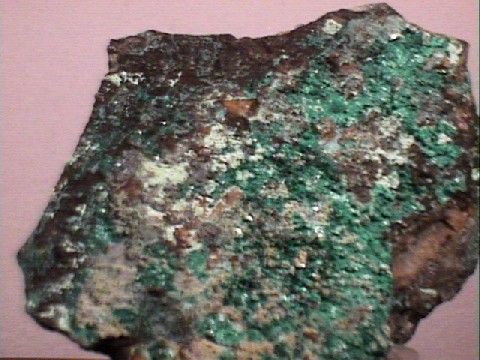
BROCHANTITE specimen bro-12
$ 25.00
$ 25.00
Dims: 3.8 x 2.4 x 1.3" (9.6 x 6.1 x 3.4 cm)
Wt: 7.0 oz. (199 g)
Cerro Verde, Sonora, Mexico
A crust of crystalline and botryoidal Brochantite coats one face of the gray base rock of this large hand specimen. The crystals on this piece are heavily intergrown with more massive material on the crust, and do not exceed 1 or 2 mm in length. Their monoclinic bladed form is arranged in small, compact, lamellar masses and is often aggregated with the crust. The small botryoidal formations are generally in good condition. The Brochantite has the standard deep green color of its specie and a luster that ranges from pearly to dull.

bro-12 ($ 25.00)
Cerro Verde, Sonora, Mexico
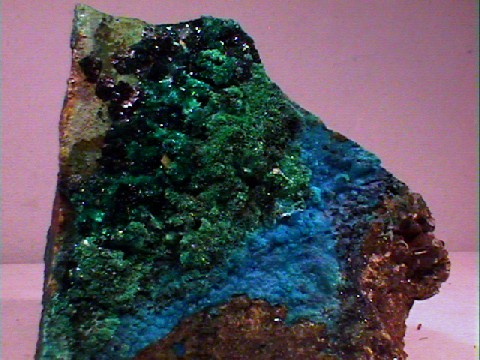
BROCHANTITE specimen bro-13
$ 45.00
$ 45.00
Dims: 2.6 x 2.5 x 2.0" (6.7 x 6.3 x 5.0 cm)
Wt: 9.5 oz. (269 g)
Douglas Hill, Lyon County, Nevada, U.S.A.
A crust made up of 3 separate minerals rests on the copper-laden base of this cabinet piece. The Brochantite section of the crust is the only one that contains definable crystals; these are generally in very good condition, as they show a moderate amount of crushing damage. These monoclinic blades are tiny, not exceeding 0.1" (3 mm) in length, and tend to aggregate into small groups that are intergrown to form the crust. All have a deep green coloration and a bright, vitreous luster. They are likely transparent, though their very deep green color and small size make this difficult to determine. A portion of this crust appears to have pseudomorphed into a different mineral- it looks very much like malachite. The final portion of the crust is made up of turquoise that shows slight evidence of botryoidal form and the classic deep aqua-blue coloration. The base rock itself is made up of several other minerals, including sphalerite and possibly cuprite.

bro-13 ($ 45.00)
Douglas Hill, Lyon County, Nevada, U.S.A.
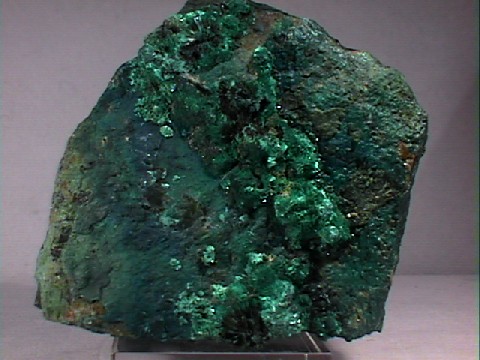
BROCHANTITE specimen bro-14
$ 36.00
$ 36.00
Dims: 2.9 x 2.4 x 1.7 (7.4 x 6.2 x 4.3 cm)
Wt: 11.9 oz. (338 g)
Douglas Hill, Lyon County, Nevada, U.S.A.
Three clusters of intergrown Brochantite sprays rest on the base of this cabinet piece. These sprays are in fair to good condition, as several are damaged, and are each made up of scores of fine, acicular Brochantite needles that do not exceed 0.3" (8mm) in length. Though too fine and intergrown to effectively study, they likely have reasonably good monoclinic form. Their green coloration is a bit paler than much of the Brochantite I have seen, but this may be due to some weathering. The needles have a pearly luster and are likely transparent as individuals. These clusters rest on a thin chrysocolla crust that coats the base rock- this crust is massive and has a waxy luster and a color that ranges from deep blue to deep blue-green.

bro-14 ($ 36.00)
Douglas Hill, Lyon County, Nevada, U.S.A.

BROCHANTITE specimen bro-15
$ 60.00
$ 60.00
Dims: 2.80x2.17x1.42" (7.1x5.5x3.6cm)
Wt: 5.44oz (153.9g)
? Sidi Bou Becker, Oujda, Morocco
This hand specimen of brochantite is rather appealing, because the crystals are in two sizes causing two colors which contrast. The host rock is limonite, upon which formed clusters of relatively large brochantite crystals. They are well formed, and a very dark green in color. Individually, the crystals are intensely green and transparent. Interspersed among these crystals is a mat of acicular brochantite crystals, and these appear much lighter in color to the unaided eye, giving the nice contrast I noted earlier. Under a loupe, all of the crystals are the same intense green, which is surprising given the different appearance to the naked eye.


bro-15 ($ 60.00)
? Sidi Bou Becker, Oujda, Morocco
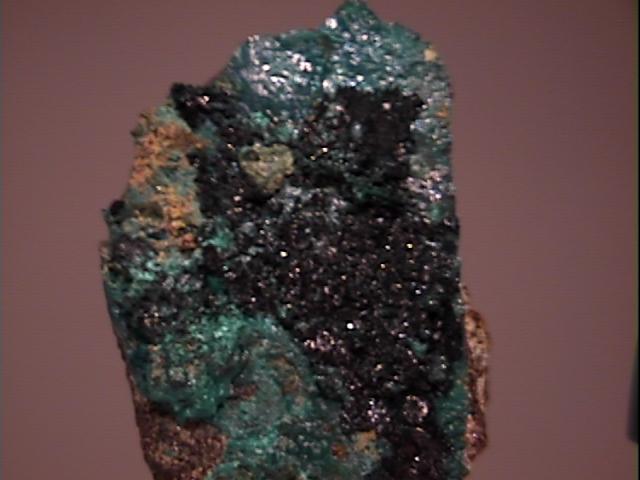
BROCHANTITE specimen bro-16
$ 45.00
$ 45.00
Dims: 2.45x1.76x1.32" (6.21x4.47x3.36cm)
Wt: 3.46oz (98.0g)
Douglas Hill, Lyon County, Nevada, USA
At first glance, this specimen displays a greenish-black sparkly crust on a layer of turquoise-colored chrysocolla. A loupe reveals that the greenish-black crust is actually composed of deep green crystals of transparent brochantite on a layer of fine brochantite needles that are so dark as to appear black (they are clearly a dark green under a bright light). There is also a yellow-green mineral present which (other than color) looks just like the chrysocolla.

bro-16 ($ 45.00)
Douglas Hill, Lyon County, Nevada, USA
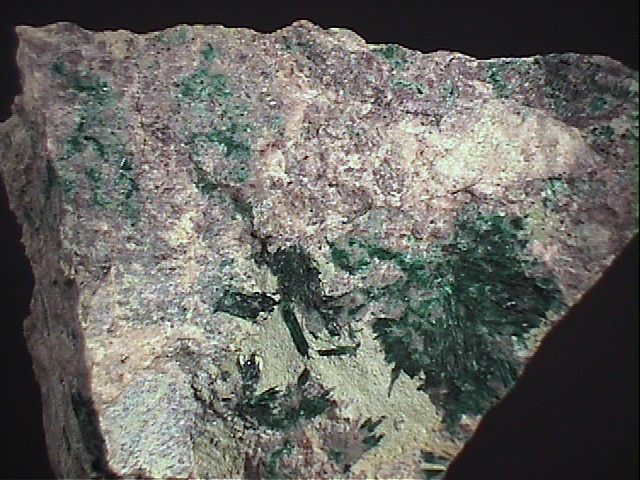
BROCHANTITE specimen bro-17
$ 28.00
$ 28.00
Dims: 2.58x2.50x1.43" (6.56x6.34x3.64cm)
Wt: 7.51oz (213g)
Morenci Mine, Greenlee County, Arizona, USA
This rock displays brochantite crystals on several sides. While flat, they are not properly a crust as they are simply flat crystals, generally with a radial form, against the side of the rock, and likely formed in a crevice. A loupe reveals that these brochantite crystals are a brilliant green, highly transparent, and with a vitreous luster. Most brochantite is acicular, so these are nice crystals. Some of them show rounded terminations that help to distinguish these from their close cousin antlerite. Under the brochantite is another mineral, opaque and black, with the same form. Either the brochantite is an oxidation product of this mineral, or they are both brochantite with the earlier growth having the black appearance.


bro-17 ($ 28.00)
Morenci Mine, Greenlee County, Arizona, USA

BROCHANTITE specimen bro-18
$ 70.00
$ 70.00
Dims: 4.34x2.36x1.74" (11.03x5.98x4.42cm)
Wt: 12.63oz (358g)
Douglas Hill, Lyon County, Nevada, USA
This specimen displays a druze of lovely deep green brochantite crystals over a muilti-colored host rock. The individual brochantite crystals are tiny, transparent and have a vitreous luster. Thre are a few small spots where the brochantite is fibrous and appears light green and opaque. Under the brochantite are several unidentified crusts. Most apparent is a thin botryoidal crust that has a blue-green color and appears translucent. Another patch appears a dull yellow-gray-green (possibly mottramite), and still other areas appear dull brown (possibly descloizite), with a fracture pattern that looks like an agate.


bro-18 ($ 70.00)
Douglas Hill, Lyon County, Nevada, USA

BROCHANTITE specimen bro-19
$ 120.00
$ 120.00
Dims: 4.25x2.83x1.40in (10.79x7.18x3.55cm)
Wt: 13.62oz (386g)
Mujuram, Morocco
This specimen displays a great deal of brochantite as radial clusters of transparent deep green acicular crystals. While much of the exposed brochantite has undoubtedly been fractured off, many clusters are in pristine condition, expecially those in protected cavities. In some areas, the deep green brochantite in intergrown with deep blue linarite crystals, making this specimen expecially pretty when viewed with a loupe.


bro-19 ($120.00)
Mujuram, Morocco